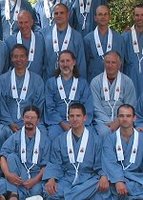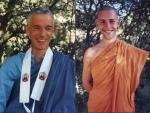 Last weekend I was away at a national gathering of the Western Buddhist Order in the UK. 340+ order members, a little less than half the UK order were there - practising together in harmony. So it seems fitting that this week I write about the Order. One of the aspects of our order which appears to cause consternation in some traditional Buddhists is that we are not a monastic order. So I'd like to spend some time looking at two related questions: Why did Sangharakshita found a non-monastic order? And, are we therefore a lay order?
Last weekend I was away at a national gathering of the Western Buddhist Order in the UK. 340+ order members, a little less than half the UK order were there - practising together in harmony. So it seems fitting that this week I write about the Order. One of the aspects of our order which appears to cause consternation in some traditional Buddhists is that we are not a monastic order. So I'd like to spend some time looking at two related questions: Why did Sangharakshita found a non-monastic order? And, are we therefore a lay order?The received tradition of Buddhism allows for two categories of Buddhists - the full-timer, or bhikkhu (literally one who begs), who is bald, robed, celibate and somehow engaged in spiritual practice; and the part-timer or householder who is mainly focused on business and family, and who's spiritual duty is to feed the full-timer. Reggie Ray notes, in Buddhist Saints in India
Eventually, perhaps because they recorded the texts, the settled monastic came to be seen in the texts as the ideal Buddhist in the Southern Buddhist countries. The Himalayan Buddhists, especially in the Nyingma school, have tended to have a more diverse social structure: for example they have married lamas and full-time practitioners who are not monks. Later, with the emergence of truly Japanese forms of Buddhism in the Kamakura period, the Japanese abandoned the vinaya which meant they could have married clergy, and that Zen monks could work for their living. However the meme that the bhikkhu is the ideal Buddhist is one that persists.
 Sangharakshita spent nearly twenty years living in India, was ordained as a bhikkhu, and had plenty of opportunity to observe modern day bhikkhus. And what he saw was a lot of men going through the motions, shaving their heads, wearing robes, and refraining from meals after noon, but not actually attempting to Awaken. Although there may have been exceptions, formalism seems to have been the rule. We get a hint of why from Peter Masefield, an academic and Theravidan Buddhist, in his book Divine Revelation in Pali Buddhism, where he concludes that without the direct intervention of a Buddha that Awakening is impossible, and within a generation of the Buddha's parinibbana Arahants would have died out. Actually Masefield, despite his voluminous citations, has overlooked a vast number of examples which contradict his conclusions and the book is deeply flawed, although still in print. But if Awakening is not possible, then what is the point? The Tibetan Buddhists that Sangharakshita met did seem to have a living Buddhism. Despite the fact that many of them were not following the vinaya to the letter, or at all, they had a depth of practice that inspired Sangharakshita.
Sangharakshita spent nearly twenty years living in India, was ordained as a bhikkhu, and had plenty of opportunity to observe modern day bhikkhus. And what he saw was a lot of men going through the motions, shaving their heads, wearing robes, and refraining from meals after noon, but not actually attempting to Awaken. Although there may have been exceptions, formalism seems to have been the rule. We get a hint of why from Peter Masefield, an academic and Theravidan Buddhist, in his book Divine Revelation in Pali Buddhism, where he concludes that without the direct intervention of a Buddha that Awakening is impossible, and within a generation of the Buddha's parinibbana Arahants would have died out. Actually Masefield, despite his voluminous citations, has overlooked a vast number of examples which contradict his conclusions and the book is deeply flawed, although still in print. But if Awakening is not possible, then what is the point? The Tibetan Buddhists that Sangharakshita met did seem to have a living Buddhism. Despite the fact that many of them were not following the vinaya to the letter, or at all, they had a depth of practice that inspired Sangharakshita.Another facet of Indian Buddhism was that the Mahabodhi Society was, at that time, run by Hindus. Anyone could be elected to the governing body and ambitious Hindus had muscled there way onto the executive, even though they were not Buddhists, and some were even antithetical to Buddhism. This prevented the society from functioning effectively.
Back in England in 1964, Sangharakshita found that nascent British Buddhism was thriving, but in a narrow way. It was all very genteel and quite sectarian. Sangharakshita found the insistence on strict Theravadin interpretation of Buddhism a bit stifling. Fortunately the English Sangha Trust decided to break off relations with Sangharakshita, which allowed him to start afresh.
After a two year return to India to wind up his affairs, and consult with his teachers, Sangharakshita returned to England with the blessing of his teachers,and set about starting a new Buddhist movement. He was sure that it was going to be run only by committed Buddhists. He was also sure that he wasn't interested in formalism.Initially Sangharakshita envisaged a hierarchy of ordinations from upasaka/upasika up to the Bodhisattva ordination. However he came to realise that since Going for Refuge was the primary act that made one a Buddhist that only one ordination, one witnessing of ones effective Going for Refuge, was necessary.
As a member of the Order I am someone who is acknowledged by my peers and preceptors to be practising effectively. I happen at the moment to have long hair; dress in jeans, teeshirts and trainers; do not have a sexual partner or children; have few possessions; live in a Buddhist community with six other men; work for a Buddhist charity; and consider myself a full-time (though far from perfect) practioner. I therefore combine aspects of the householder, and the bhikkhu, and indeed at times take up the life of a forest dweller for brief periods. Some traditionalists seem to struggle with this indeterminacy - I've been told, for instance, that because I don't follow the letter of the vinaya that I am a heretic that is distorting the Dharma. I guess it shows that fundamentalism is not something that theistic religions have a monopoly on.
So to sum up, the Western Buddhist Order is not an order of monks or lay people, it is an order of effective practitioners. This appears to be radical in the face of the monk/lay model. But that model has never been intrinsic to Buddhism, it's just a cultural norm, and one that may not be relevant any longer.
